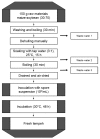Formation of Zearalenone Metabolites in Tempeh Fermentation
- PMID: 31344953
- PMCID: PMC6696204
- DOI: 10.3390/molecules24152697
Formation of Zearalenone Metabolites in Tempeh Fermentation
Abstract
Tempeh is a common food in Indonesia, produced by fungal fermentation of soybeans using Rhizopus sp., as well as Aspergillus oryzae, for inoculation. Analogously, for economic reasons, mixtures of maize and soybeans are used for the production of so-called tempeh-like products. For maize, a contamination with the mycoestrogen zearalenone (ZEN) has been frequently reported. ZEN is a mycotoxin which is known to be metabolized by Rhizopus and Aspergillus species. Consequently, this study focused on the ZEN transformation during tempeh fermentation. Five fungal strains of the genera Rhizopus and Aspergillus, isolated from fresh Indonesian tempeh and authentic Indonesian inocula, were utilized for tempeh manufacturing from a maize/soybean mixture (30:70) at laboratory-scale. Furthermore, comparable tempeh-like products obtained from Indonesian markets were analyzed. Results from the HPLC-MS/MS analyses show that ZEN is intensely transformed into its metabolites α-zearalenol (α-ZEL), ZEN-14-sulfate, α-ZEL-sulfate, ZEN-14-glucoside, and ZEN-16-glucoside in tempeh production. α-ZEL, being significantly more toxic than ZEN, was the main metabolite in most of the Rhizopus incubations, while in Aspergillus oryzae fermentations ZEN-14-sulfate was predominantly formed. Additionally, two of the 14 authentic samples were contaminated with ZEN, α-ZEL and ZEN-14-sulfate, and in two further samples, ZEN and α-ZEL, were determined. Consequently, tempeh fermentation of ZEN-contaminated maize/soybean mixture may lead to toxification of the food item by formation of the reductive ZEN metabolite, α-ZEL, under model as well as authentic conditions.
Keywords: Aspergillus oryzae; Rhizopus; food fermentation; modified mycotoxins; zearalenone sulfate; α-zearalenol.
Conflict of interest statement
The authors declare no conflict of interest.
Figures





References
-
- Hartanti A.T., Rahayu G., Hidayat I. Rhizopus species from fresh tempeh collected from several regions in Indonesia. HAYATI J. Biosci. 2015;22:136–142. doi: 10.1016/j.hjb.2015.10.004. - DOI
-
- Murata K., Ikehata H., Miyamoto T. Studies on the nutritional value of tempeh. J. Food Sci. 1967;32:580–596. doi: 10.1111/j.1365-2621.1967.tb00837.x. - DOI
-
- Steinkraus K.H., Yap Bwee H., Van Buren J.P., Provvidenti M.I., Hand D.B. Studies on tempeh–an Indonesian fermented soybean food. J. Food Sci. 1960;25:777–788. doi: 10.1111/j.1365-2621.1960.tb00026.x. - DOI
-
- Babu P.D., Bhakyaraj R., Vidhyalakshmi R. A low cost nutritious food “tempeh”—A review. World J. Dairy Food Sci. 2009;4:22–27.
MeSH terms
Substances
LinkOut - more resources
Full Text Sources
Other Literature Sources

